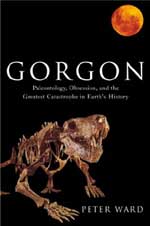
Peter Ward cut his teeth, so to speak, on a more recent mass extinction. This event was the Cretaceous-Tertiary or K/T mass extinction about 65 million years ago that saw the end of the dinosaurs and many of their co-habitants. Fortunately for people, it also paved the way for the dominance of mammals. The quest that drove Peter and other paleontologists was to find the reason for the mass extinction. After extensive investigation of the K/T boundary, the cause was ruled not to be a long, gradual climate change but a brief flash due to an asteroid hitting at Chicxulub in the Yucatan peninsula of Mexico. Peter’s own findings supported the final conclusion but seeing as it was a conclusion, Peter was left without a future target for his personal challenge.
The end of the Permian period was similar to the end of the Cretaceous period as each ended with a mass extinction. However, the Permian period was a more complete extinction and, as it occurred hundreds of millions of years beforehand, there was a lot less material to substantiate either a cause or a process. Peter fortuitously began studying this event. Over the ensuing twenty years, he experienced both political extremes in the pre and post apartheid and environmental extremes as he traversed the back country called the Karoo. He discovered much about the mass extinction and much about himself.
The lands of the Karoo do not give up their secrets easily. Though effectively a desert region, its temperature ranges from below freezing to well above 40 Celsius. Sunstroke and frostbite were equally possible. Ticks were incessant and could in one bite lead to a painful and fateful end. Puff adders and Cape cobras abounded. Clean water didn’t. Restaurants and hotels were few and far between and of limited quality. In spite of the hardships, or perhaps because of them, many every day visions took on a greater grandeur. Night skis were a crystal clear panoply of stars, galaxies and light shows. Rivers had recuperative powers better than any pharmaceutical pill. And, of course, the sighting of a fossil made the rigour of many a hard day melt away. The Karoo had the evidence needed to help explain the Permian boundary extinction but it did so grudgingly.
Being a paleontologists, as is Peter, gives perhaps a somewhat unique perspective of today’s events on Earth. Some claim that the Earth at this moment is experiencing another mass extinction. However, this time it is not due to celestial strikes but through the actions of a singular species, humans. Humanity is causing the loss of species at a rate ten times faster than at any time since the last mass extinction. In addition, with its alteration to the Earth’s environment, especially the atmosphere, many of the indicators for the start of a mass extinction are again present. Further, if a large extinction occurs, then with the human caused reduction in biodiversity, the Earth may again need tens of millions of years to achieve a full set of complex life forms. Peter raises such perspectives and in so doing easily justifies the time and effort spent examining an event hundreds of millions of years old.
This backward look in time is equally exciting for space enthusiasts. NASA itself is funding significant investigations into the Earth’s mass extinctions and the beginnings of life. The definition of life and its constituent matters may seem complete but seeing new life forms at undersea volcanoes or kilometres deep in granite lends credence to the belief that life can exist elsewhere than Earth. Further, the study of mass extinctions can lead to the definition of the processes of evolution as well as ecosystem dependencies. From this, conjecture can be raised about the effects of the loss of species and phyla, as well as the effects of another asteroid striking Earth. Such scenarios easily give NASA greater support to develop lunar bases and space travel.
After reading this book, you will discard any romantic notions you may have had about being a fossil hunter. Peter clearly describes days of sweat, years of poor pay and few occasions of reward. His personal vindications allow a reader to feel the warmth of comradery, the joys of mystery meat on pizza and the satisfaction of contributing to scientific knowledge. As much as this book reinforces a career choice other than a paleontologist, I’m glad there are people like Peter who do this work and are able to write a book for a non-practitioner to enjoy.
Yet, though I’m not a paleontologist, I would have liked a clearer description of the events and surroundings being investigated. There is a flourish that waxes about the vast expanse of life before the Permian mass extinction and the lack thereafter, but there is little detail. Also, reference is made to activities and researchers elsewhere, but these seem more of an add on than part of the narrative. Peter includes more of his feelings than details of his work, which may please or discourage the reader.
The Gorgonopsian was a predator from the Permian period. It became extinct along with about 95 percent of its fellow inhabitants on Earth at the end of this period. Peter Ward, in his book Gorgon, describes his personal challenges and successes in prying the secrets of fossils from the back country of South Africa. In reading this book, you can easily end up wondering about the huge expanse of lives and events that have gone before us, wondering about current and past politics or just wondering about what drives people to do the things they do.
You can also read a review of Ward’s previous book, The Life and Death of Planet Earth here on Universe Today.
Read more reviews, or buy a copy online from Amazon.com.
Review by Mark Mortimer
